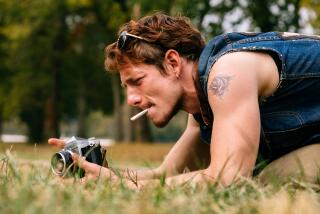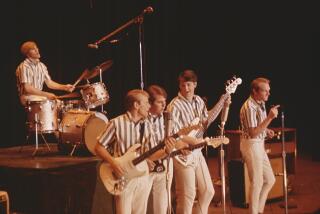B-FLICKS’ BUMBLING SLUM MUSKETEERS : BOWERY BOYS REVISITED IN BOOK BY 2 FILM BUFFS
- Share via
Brace yourself. There’s yet another pictorial chronicle of stardom during Hollywood’s Golden Age that’s out on the local book stands.
And true to formula, “The Films of the Bowery Boys” (Citadel Press, $19.95)--written by two Orange County film buffs--boasts the usual profusion of movie trivia, from scores of production stills to reams of cast credits and back lot gossip.
But this latest homage isn’t paid to the usual screen divinities, not your Garbos and Chaplins or Davises and Grants. Rather, David Hayes and Brent Walker’s book is everything you’ve always wanted to know about a gang of bumbling slum musketeers--the Bowery Boys--who starred in a string of lowly B flicks in the 1940s and 1950s.
Indeed, some movie buffs may argue that any reminiscences about the Bowery Boys, whose films were either ignored or ridiculed by most critics of that day, are best left buried in the footnotes of Hollywood history books.
But Walker and Hayes believe otherwise. They argue that their heroes represent an affectionately remembered Hollywood genre, even among post-1950s viewers. “There’s a lot of fans like us, who have grown up with the Bowery Boys (on television revivals). To us, the boys are old friends--real lovable, flaws and all,” said Hayes, 22, who began writing the book while a student at Dana Hills High School in Dana Point.
Early sales reports appear to back the authors’ optimism. According to Citadel Press, a major publisher of pictorial film histories since 1967, “The Films of Bowery Boys” has sold about 4,000 copies in two months, mostly in the “big movie-buff markets” of Los Angeles, New York, Chicago and San Francisco. Added Allan Wilson, editor of the New Jersey-based firm, “We feel this book will be one of our solid sellers--about 8,000 altogether in hardback and another 30,000 when we go paperback (in two years).”
Citadel and authors Walker and Hayes hope to cash in on the latest fad in movie biographies: homages to Hollywood’s earlier B series heroes. Citadel itself has published tributes to the Tarzan and Sherlock Holmes epics, plus three books alone on the Three Stooges comedies (the Stooges, rediscovered by young television-era fans, enjoy a huge cult status at theater festivals and on television).
“We hope our book can achieve something of the same impact that the Stooges’ books have,” said Walker, also 22 and a Dana Hills graduate (he was a research assistant on the best-selling “Three Stooges Scrapbook”). “We want ours to be the force for bringing their (Bowery Boys’) fans together, something around which they, too, can rally.”
At one time, the Bowery Boys might have seemed unlikely candidates as screen idols. They were a spinoff of a group of teen-age actors in the late 1930s known as the Dead End Kids, who were usually cast as Depression slum-bred toughs on their way to or from reform schools.
The youths--Billy Halop, Leo Gorcey, Bobby Jordan, Gabriel Dell, Huntz Hall and Bernard Punsley had first appeared on Broadway in a grimly realistic street drama, Sidney Kingsley’s “Dead End.” Then Hollywood mogul Samuel Goldwyn brought the youths to Hollywood for the 1937 screen version of “Dead End,” which featured Humphrey Bogart, doing his mobster bit.
Warner Bros. then put the gang (billed as the Dead End Kids) in one crime melodrama after another. The most celebrated of the lot was “Angels With Dirty Faces” with James Cagney, doing his mobster bit. (In two other Warner films, the youths appeared with another studio player, Ronald Reagan.) But the gang’s films quickly slipped from A-movie status at Warners to the low-budget, quickie variety at Universal and at Monogram, a Hollywood studio known for its low-budget movies. (Also at Monogram, the gang, minus Halop, the original leader, became billed as the East Side Kids.)
By 1946--when the gang became known as the Bowery Boys--the series no longer made any pretense at social realism. Instead, the Monogram-produced films became the wildest slapstick, going by such titles as “Spook Busters,” Let’s Go Navy,” “Loose in London” and “Bowery Boys Meet the Monsters.” The plots, usually to do with the gang’s farcical struggles with upward mobility, centered on the tomfoolery between the two leads: Leo Gorcey as “Spit,” the gang’s sardonic but malaprop-prone leader, and Huntz Hall as “Sach,” a character of sublime sappiness.
Despite their bottom-of-the-bill status, the Bowery Boys films were howling successes with the Saturday matinee crowds at movie houses. After Monogram put an end to the series in 1958 (Gorcey had already quit the series in 1955 and the “boys” by then were well into their 30s), the films were revived continuously on television--where Brent Walker and David Hayes first saw them in the mid-1970s.
“We were struck by the great sense of exuberance in their films. You know, many of the films were really quite marvelous spoofs, full of comic ingenuity and skillful interplay,” said Hayes, who seeks to establish a career as a writer-critic on screen history. “In a way, their films are classics, despite all the years of (critical) indifference.”
For four years, Hayes and Walker worked on their Bowery Boys project, scouring Hollywood archives, memorabilia shops and private collections for any and all production data and anecdotes on the “boys” and their predecessors, the East Side Kids and the Dead End Kids. Although the authors did not extensively interview the surviving key gang members, the book’s epilogue is a highly detailed, at times poignant, chronicle of gang alumni (including such lesser-known members as Billy Benedict, David Gorcey and “Sunshine Sammy” Morrison, and the actor who led the gang in the final films, Stanley Clements).
Only two members established substantial careers on stage and television after the series: Huntz Hall, who is still active as a star on the dinner-playhouse circuit, and Gabriel Dell, who has performed major roles on Broadway in “Luv” and other works. But Leo Gorcey, who led a well-publicized, tumultuous off-screen life, was never able to break from being typecast as the street tough. (Gorcey died in 1969 at age 52.) And Billy Halop, once considered the most promising actor in the early Dead End Kids films, never achieved screen prominence. (Halop, who had a small regular part as a cabbie in the “All in the Family” television series, died in 1976 at 56.)
“To us, the boys, as we want to remember them, live on in their films. They’re real rebels, real go-getters, trying to cope with their social environment the best they know how, even if it’s all for laughs,” said Walker, who majored in film and television production at Cal State Fullerton. “We think of them as genuine, larger-than-life screen heroes.”
More to Read
Sign up for our Book Club newsletter
Get the latest news, events and more from the Los Angeles Times Book Club, and help us get L.A. reading and talking.
You may occasionally receive promotional content from the Los Angeles Times.










